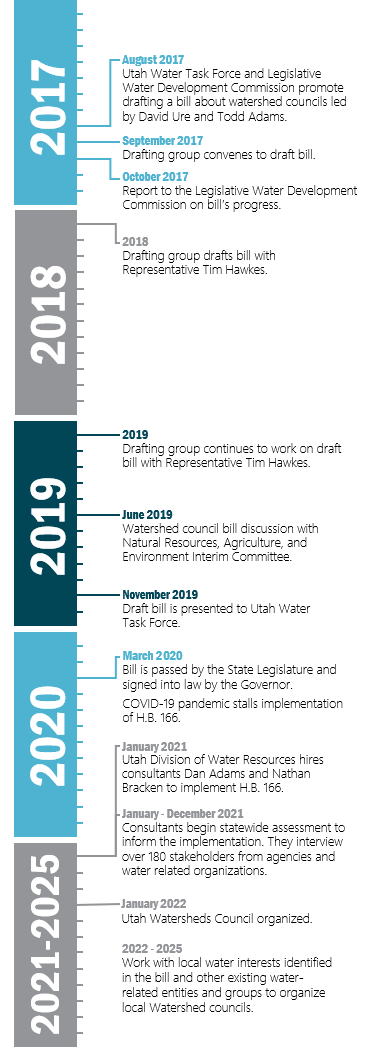
Watershed Councils Act & Implementation
In 2020, the Utah Legislature passed the Watershed Councils Act (HB 166), which authorized and directed the Division of Water Resources to create the Utah Watersheds Council (a state council) and twelve local watershed councils. The act’s intent is to develop diverse and balanced stakeholder forums for discussion of water policy and resource issues at watershed and state levels. These councils do not have any regulatory, infrastructure financing, or enforcement powers or responsibilities.
The Utah Watersheds Council will encompass the entire state and facilitate the establishment of the 12 local watershed councils. 11 local watershed councils will be developed according to the Division of Water Resources’ hydrologic basin map . A 12th local watershed council will be organized for the Great Salt Lake Basin*.
Each basin is assigned an Area Planning Specialist within the Division of Water Resources. As part of their duties, the specialists act as a liaison between the Division and the watershed councils.
In 2021, the division hired The Langdon Group to assist with implementation of the act. This webpage was created to provide basic information about the authorized watershed councils and to comply with the requirements of the Watershed Councils Act.
For general inquiries, email watershedcouncils@utah.gov.
*The Great Salt Lake Watershed Council will be comprised of the five watersheds that drain into Great Salt Lake. These are the Bear River, Weber River, Jordan River, Utah Lake and West Desert watershed councils.
How can I be involved?
If you would like to be informed about the Utah Watersheds Council, your local watershed council, or if you have any questions or ideas please contact us. We are here to serve you and help ensure that the watershed councils bring benefit to you and the State of Utah.
- Todd Stonely, Utah Division of Water Resources, 801-538-7277 or toddstonely@utah.gov
- Carly Payne, Administrative Support, Utah Division of Water Resources, 801-538-7235 or carlypayne@utah.gov
- Dan Adams, The Langdon Group, 801-520-4762 or dadams@langdongroupinc.com
- Hollee Wood, The Langdon Group, hwood@langdongroupinc.com
Where are we in the implementation process?
During 2021, the implementation team met with over 200 individuals across the state to understand how to implement the Utah Watershed Councils Act and realize its opportunities. The Utah Watersheds Council began meeting in January 2022.
Local watershed councils began to convene during the spring of 2023.
The implementation of the act will be completed by Fall 2024.
Additional Resources
As part of the NOWC Insider Webinar Series, on April 26, 2022, Jon A. Souder, Ph.D., Forest Watershed Extension Specialist, Oregon State University presented on the Life Cycles of Watershed Councils. The links below provide details of this informative presentation.
Abstract: Like salmon, watershed councils have life cycles with various stages requiring different “habitats” to be successful. This talk identifies the characteristics of each stage and highlights the behaviors and types of people most attracted to each stage. This linkage of life stage and behavior allows for organizations to build staff and Boards appropriately.
- Presentation recording
- NOWC Life Cycles of Watershed Councils Slide Deck
This presentation was developed from a chapter written by Jon Souder in Stream and Watershed Restoration: A Guide to Restoring Riverine Processes and Habitats, First Edition. Philip Roni and Tim Beechie. © 2013 John Wiley & Sons, Ltd. Published 2013 by John Wiley & Sons, Ltd. - Chapter 4: The Human Dimensions of Stream Restoration: Working with Diverse Partners to Develop and Implement Restoration

